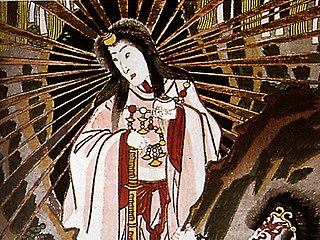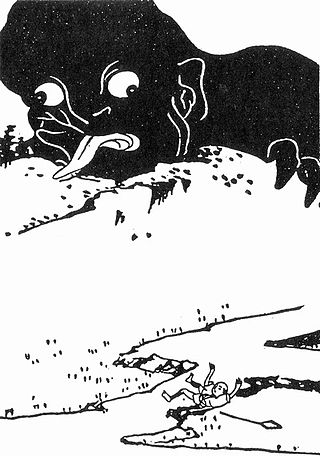Related Research Articles

Shinto is a religion originating in Japan. Classified as an East Asian religion by scholars of religion, its practitioners often regard it as Japan's indigenous religion and as a nature religion. Scholars sometimes call its practitioners Shintoists, although adherents rarely use that term themselves. There is no central authority in control of Shinto, with much diversity of belief and practice evident among practitioners.

Tahō Fuji Dainichirenge-san Taiseki-ji, more commonly just Sōhonzan Taiseki-ji (総本山大石寺), informally known as Head Temple Taiseki-ji (大石寺), is the administrative center of Nichiren Shoshu Buddhism. It is located in the foothills of Mount Fuji in Kamijo, Fujinomiya, Shizuoka Prefecture, Japan. Taiseki-ji was founded in 1290 by Nikkō Shōnin, one of Nichiren Daishonin's senior disciples, on a land parcel donated by the pious believer Daigyo Sonrei, commonly known as Nanjo Tokimitsu (1259–1332).
Mahikari is a Japanese new religious movement (shinshūkyō) that was founded in 1959 by Yoshikazu Okada (1901–1974). The word "Mahikari" means "True Light " in Japanese.

Sukyo Mahikari is an organization with centers in more than 100 countries. The stated aim of the organization is to help people improve the quality of their lives and attain happiness by practicing universal principles and a method of spiritual purification called the art of True Light. It was founded by Kōtama Okada in 1959 under the name L. H. Yokoshi no Tomo. Sukyo Mahikari was registered on June 23, 1978, by Keishu Okada as part of an amicable settlement following the passing of Kōtama Okada. In 2013, Sukyo Mahikari announced it had a membership of approximately one million practitioners.

In Japanese mythology, Takamagahara, also read as Takaamanohara, Takamanohara, Takaamagahara, or Takaamahara, is the abode of the heavenly gods (amatsukami). Often depicted as located up in the sky, it is believed to be connected to the Earth by the bridge Ame-no-ukihashi.

Gwalleuk was a Korean Buddhist monk from the kingdom of Baekje who lived during the time of King Wideok. In 602, he travelled to Japan and is known for helping to spread the teachings of Taoism and Buddhism to Japan. In particular, he brought over fangshu texts related to the likes of geomancy and onmyōdō, as well as a calendar, according to the Nihon Shoki. In 624, he was made a high priest, possibly of Gangō-ji, for the rest of his life.

Fabian Fucan was a Japanese writer who converted from Christianity to Japanese Zen Buddhism in his youth. He was an apostate. He wrote tracts at first advocating and later criticizing Christianity in comparison to the other religions of Japan.

The Most Venerable Etai Yamada was the 253rd head priest of the Japanese Tendai school of Mahayana Buddhism.

Daidarabotchi was a gigantic type of yōkai in Japanese mythology, sometimes said to pose as a mountain range when sleeping.
Gedatsu-kai, or Nirwana Association, is a Japanese new religious movement founded in 1929. The number of adherents exceeded 200,000 in the 1990s. It is a syncretic movement, with influences drawing from traditional Shinto and Shingon Buddhist teachings. Its central deity is Gochi Nyorai (Mahāvairocana). Gedatsu is the Japanese term for moksha or enlightenment. Gedatsu-kai is a non-sectarian study, having no firm affiliation with any existing religious groups.
Fabio Rambelli is an Italian academic, author and editor. He is a professor in the Department of Religious Studies at the University of California, Santa Barbara (UCSB).
Annen was a Japanese Buddhist monk and scholar who systematized the esoteric teachings in the Tendai school, otherwise known as Taimitsu (台密). He thereby became the first to complete the formal esoterization of Japanese Tendai.
This article presents a selected bibliography of Tenrikyo, a Japanese new religion.
The Zoku-Jōmon period (続縄文時代), also referred to as the Epi-Jōmon period, is the time in Japanese prehistory that saw the flourishing of the Zoku-Jōmon culture, a continuation of Jōmon culture in northern Tōhoku and Hokkaidō that corresponds with the Yayoi period and Kofun period elsewhere. Zoku-Jōmon in turn gave way to Satsumon around the seventh century or in the Nara period (710–794). The "Yayoinisation" of northeast Honshū took place in the mid-Yayoi period; use of the term Zoku-Jōmon is then confined to those, in Hokkaidō, who did not "become Yayoi". Despite the elements of continuity emphasised by the name, which include the continuing production of cord-marked ceramics, ongoing employment of stone technology, and non-transition to rice-based agriculture, all Jōmon hallmarks, the Zoku-Jōmon period nevertheless saw a "major break in mobility and subsistence patterns".

A shukubo(宿坊) is a temple lodging in Japan that allows visitors to stay overnight within a Buddhist temple. Originally, these facilities were designed to accommodate only monks and worshippers, but nowadays, in response to declining numbers of monk visitors, most facilities accept general tourists. Some temples, such as Mount Kōya, have open-air baths with onsen. Shukubo are now considered semi-secularized and in many towns are the only accommodations available.
The Missionary Office was one of the government offices in Japan during the Meiji period (1868-1912).
Inoue Nobutaka, is a Japanese scholar of religious studies, who specializes in modern Shinto studies. He is a professor emeritus at Kokugakuin University.

Kōshiki is a musical genre used in Japanese Buddhism rituals. It originated from the Tendai belief in the late tenth century, and later spread to other Buddhist schools. It is a form of narrative music, and often incorporates foreign non-Buddhist deities.
James E. Ketelaar is an American scholar and historian specializing in the religious, philosophical, and intellectual history of Japan. He is professor emeritus in the Department of History, the Department of East Asian Languages and Civilizations, and the Divinity School at the University of Chicago, where he has been teaching since 1996.

Overseas Shinto designates the practice of the Japanese religion of Shinto outside Japan itself. Shinto has spread abroad by various methods, including the imperial expansion of the Empire of Japan during the Meiji period, the migration of Japanese to other countries, and the embrace of Shinto by various non-Japanese individuals.
References
- 1 2 Writers Directory. Springer. 2016-03-05. ISBN 978-1-349-03650-9.
- 1 2 Evory, Ann (1979). Contemporary Authors. Gale / Cengage Learning. p. 148. ISBN 978-0-8103-0040-8.
- 1 2 3 Moon, Jill (2020-08-19). "Illinoisan's story a tribute to everyday Americans". Alton Telegraph . Archived from the original on 2022-01-10. Retrieved 2020-11-19.
- ↑ "H. Byron Earhart". Cengage EMEA. Retrieved 2020-11-18.
- ↑ "H. Byron Earhart". Western Michigan University. Retrieved 2020-11-18.
- ↑ "Western news". October 15, 1981.
- 1 2 Thumas, Jonathan (2013-09-22). "H. Byron Earhart, Religion in Japan: Unity and Diversity (fifth edition)". Japanese Journal of Religious Studies . 40 (2): 383–386. doi: 10.18874/jjrs.40.2.2013.383-385 .
It is no surprise that H. Byron Earhart's classic textbook, Japanese Religion, has remained one of the only treatments of Japanese religious history truly suitable for use in undergraduate classrooms. During its long publication history, Japanese Religion has, without equal, fulfilled and exceeded its role as a useful teaching material. Earhart has proved through various editions that his work remains relevant and indeed the foremost resource for those teaching introductory courses on Japanese and East Asian religions. This continues to be the case in the latest, fifth edition, aptly titled Religion in Japan.
- ↑ Reid, David (1982). "Review Of: H. Byron Earhart, Japanese Religion: Unity and Diversity". Japanese Journal of Religious Studies. 9 (4): 313–315. doi: 10.18874/jjrs.9.4.1982.313-315 .
- ↑ Aubin, Françoise (1984). "Earhart (Byron) Japanese Religion. Unity and Diversity". Archives de sciences sociales des religions (in French). 57 (2): 228–229.
- ↑ Lee, Andrew (2013-11-30). "Religion in Japan: Unity and Diversity". The Japan Times . Retrieved 2020-11-19.
- ↑ Blacker, Carmen (1971). "H. Byron Earhart: The new religions of Japan: a bibliography of Western-language materials. (Monumenta Nipponica Monograph Series.) xi, 96 pp. Tokyo: Sophia University, [1970]". Bulletin of the School of Oriental and African Studies . 34 (3): 679. doi:10.1017/S0041977X00129428. ISSN 1474-0699. S2CID 162313830.
- ↑ Ellwood, Robert S. (1971). "Review of The New Religions of Japan: A Bibliography of Western-Language Materials". Journal of the American Academy of Religion . 39 (1): 89–92. doi:10.1093/jaarel/XXXIX.1.89. ISSN 0002-7189. JSTOR 1461684.
- ↑ Hardacre, Helen (1984-08-01). "The New Religions of Japan: A Bibliography of Western-Language Materials. H. Byron Earhart". History of Religions . 24 (1): 89–90. doi:10.1086/462979. ISSN 0018-2710.
- ↑ Reid, David (Mar 1, 1984). "The new religions of Japan: A bibliography of Western-language materials, 2nd edition (Book Review)". Japanese Journal of Religious Studies. doi: 10.18874/jjrs.11.1.1984.95-96 .
- ↑ Mansfield, Stephen (Feb 26, 2012). "Fuji-san: reflections on Japan's iconic mother mountain". The Japan Times.
- ↑ MacWilliams, Mark (December 2014). "Mount Fuji: Icon of Japan. By H. Byron Earhart. Columbia: The University of South Carolina Press, 2011. Pp. 239". Religious Studies Review . 40 (4): 232. doi:10.1111/rsr.12185_2. ISSN 1748-0922.